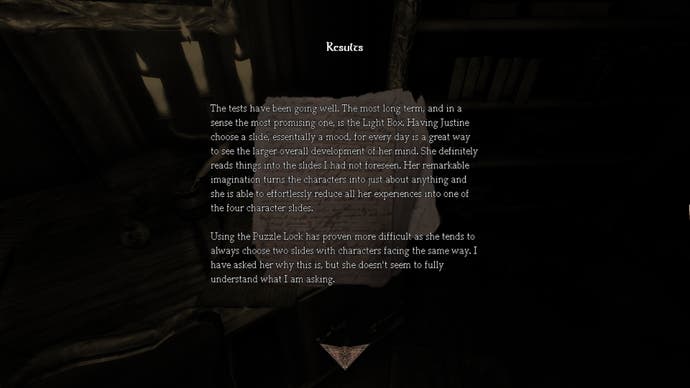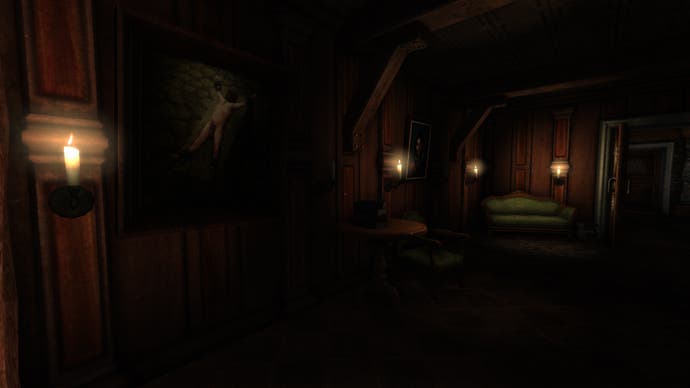Amnesia: Justine is the keystone in a series that goes beyond fear
A Freud of the dark.
If you've heard of the Amnesia games before, then you've probably also heard that they're scary. I've certainly come across several claims that they are the "scariest games of all time" and even a few people have suggested that the games are too scary to complete. The success of the first game in the series, Frictional Games' 2011 Amnesia: Dark Descent, was contingent on its terrifying nature; its cat and mouse chases featuring in a hundred Let's Plays and streams, where grown adults hid in corners, faced the wall and whispered to themselves repeatedly that "everything is going to be OK".
Spurred on by these brave pioneers, players flocked to the game, eager to test their mettle. But why? Perhaps it was the rush, the adrenaline of an imagined brush with death. Maybe it was the draw of the unknown, a desire to plumb the darkest depths in search of something other, something new. In some senses it doesn't matter: When it comes to video games fear is fun. We've all felt it, we all know it, why not leave it at that?
But what if there's something underneath that fear? What if it's just a mask, a layer, which sits on top of something else? What if we are looking at the tip of an iceberg, but beneath the dark, choppy waves lies a vast unknown mass, a container of emotions, ideas and secrets that we never knew was there.

That's the guiding principle of the Amnesia series. About to be re-released to fresh screams of terror as the Amnesia Collection on PS4 (which includes the two main games, Amnesia: Dark Descent and Amnesia: A Machine for Pigs as well as the free DLC Amnesia: Justine) the series is marked not just by an ability to evoke fear, but by something more complex too; a fascination with psychological depths that betrays a sophisticated nature.
It's there in the scattered notes and loading screen exposition of Dark Descent, and even more present in the audiograph ramblings of A Machine for Pigs. But while those two games blend their mental trauma with occult fascination or machine gods, it is the oft forgotten Amnesia: Justine that doubles down on the idea of a horrifying psychological portrait. Commissioned by Valve as a tie-in for the release of Portal 2, Justine takes the form of a series of 'tests' that might seem familiar to fans of the Saw films and their brand of funhouse horror. Instructed by a series of audiographs that resemble the narration of Portal 2's GlaDOS, Justine puts you under the instruction of its titular aristocrat in her ornate torture chambers. Save her victims, or orchestrate their grisly ends, the choice is yours. It is by turns campy, odd and once it lets its monsters out, distinctly terrifying.
Like the other Amnesia games, Justine asks players to stalk through murky vaults while AI monsters track them through the dark. These tense encounters are what the Amnesia games are known for, and they are no less unnerving here. But unlike the other games in the series, the punishment for death in Justine is not simply being knocked back to a checkpoint, but instead being booted from the game entirely. It's a merciless twist, one that evokes a distinct sense of shock, as you stare at your desktop icons, the last image of whatever monstrosity felled you still burned into your retinas. While I doubt the upcoming PS4 collection will so brutally pull you out of the game, I don't think the shock and finality of this feature will be any less acutely felt by players.
However, as horrifying as this permadeath system might sound, it is not the main attraction of Justine. Instead, the game hinges around plumbing the depths of a broken mind. As Justine progresses over its short running time, it becomes clear its 'tests' are a process of unearthing, a slow clawing away at the past and at Justine's psyche, to uncover the unnerving truths beneath.

This idea is one that connects Justine, and the Amnesia series at large, to a history of works that blend both horror and self-discovery. It was the father of psychoanalysis, Sigmund Freud, who first introduced the image of the iceberg to represent the arrangement of the human mind. His idea was that small, visible tip of the iceberg above the water represented the conscious mind, while the unconscious mind, in which our desires, repressed memories and emotions operate, is represented by the vast unseen block of ice below the surface. Though this so-called "topographical model" of the human mind has since come under much scrutiny, and the existence of the unconscious mind has even been brought into question, Freud's image and the ideas behind it have remained a compelling conceit for artists, writers and, more recently, developers.
Justine is a game spun off from these ideas and images, crafting a psychoanalytical topography out of the series' typical arrangement of stygian dungeons and waterlogged crypts. A journey through these spaces drags the player through both Justine's deep unconscious, murderous thoughts, and her higher carefully ordered, conscious mind. Its conclusion in particular, without wanting to spoil anything, makes a wonderful use of the topographical model of human psychology to show that it isn't always about descending through layers of buried desire towards some dark secret, but that an ascent to the conscious portion of the mind can be just as disturbing when you know what's hiding underneath.
This transformation of psychological topography into level design layout is something that can be found across the Amnesia series. The direction of travel in The Dark Descent is suggested by its title, but it's the way that this descent ties into a process of self-discovery for the protagonist Daniel that makes it so compelling. Much attention has been paid to the series' obvious evocations of terror; "sanity effects" that make the screen squirm and your ears ring with wails and tinnitus, pale monstrosities with rasping breath and unearthly screams, but less has been paid to the slow gathering fear of their narratives. All of the Amnesia games are structured around protagonists whose shattered minds are filled with unpleasant things, their histories returning like bloodstains that emerge out of once clean carpets or from behind delicately flowered wallpaper. These narrative discoveries are mirrored by the growing strangeness of the spaces you navigate in the games, with developer The Chinese Room's ambitious contribution to the series, A Machine for Pigs, demonstrating this most effectively in its journey from precise London town house to hellish production line of fleshy monstrosities.

Each game in the series is, in its own way, both an unearthing of repressed memories and a study of the horror of interior architecture, of its ability to evoke claustrophobia, fear and despair. The collections of rooms and corridors that make up Amnesia's castles, crypts, factories and houses lead like an unsteady train of thought to a perverse conclusion. And as these spaces are prone to cave-ins, distortions and room-rattling shifts it's also easy to get the sense that they are not real buildings but instead the anatomical passages of some vast suffering creature. A Machine for Pigs makes this idea explicit, its subterranean machine of inhuman cruelty a symbol for the collected human mass of suffering that will take place over the course of the mechanised wars and genocides of the 20th century. The Chinese Rooms' choice of New Year's Eve 1899 as the games setting puts it at the verge of a horror that we know is coming, one bigger than any individual psychological trauma.
Yet because of this, A Machine for Pigs, in its powerful and surreal vision, loses something of the intimacy of Justine. And while The Dark Descent has an equal path of unpleasant revelations to follow, its tendency towards the work of HP Lovecraft leads it away from psychological horror towards something more fantastical. Justine, in comparison, manages to explore its psychoanalytical ideas without being weighed down by them.
The result is the epitome of everything the Amnesia series aspires to be. Justine may lack the polish and the slow-burn of its full-size siblings, but in 30 minutes or so it presents the blend of psychological spelunking, full blown terror and head spinning trickery that marks the series out as a singular achievement among a landscape of cheap jump scares and throwaway gore.
The Amnesia series may well be the scariest set of games ever made, or it may not, but what matters is that if you strip away the monsters and the fantasy you have a handful of games with a genuine interest in the divine, the perverse and ultimately, the hidden darkness of the human condition.

